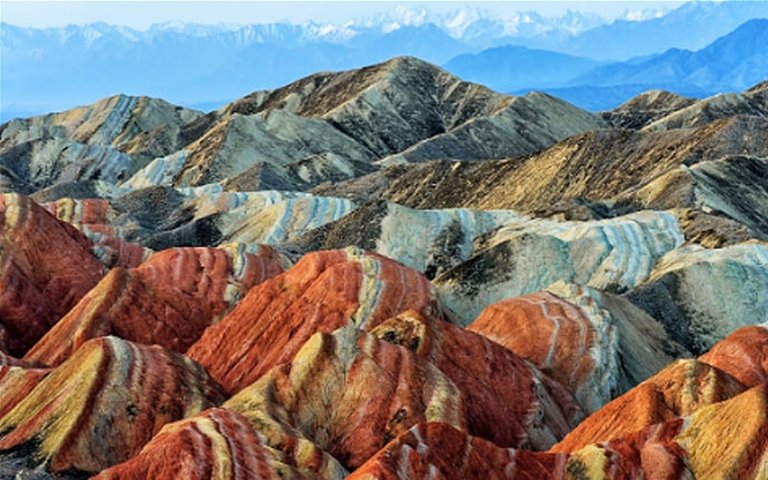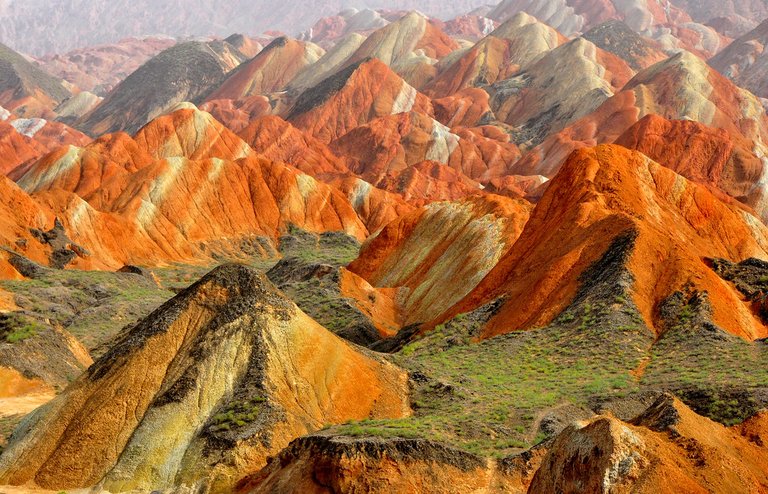Secret Behind The Zhangye Danxia Colored Mountain
If you are told you are going to see a mountain, what comes to mind is a mountain made up of either igneous rocks or a sedimentary one, only unless you are going to icy regions is when you think of seeing ice as mountain but you would never think of a colored sedimentary rock until you see Zhangye Danxia National Geopark in China where the mountain has a rainbow like color landscape.
Zhangye Danxia National Geopark is made up of sedimentary rocks which are is composition of sand, silt, stick, and stones come together to form rock. Zhangye Danxia National Geopark mountain is made of rocks layers which transition into one another gradually and are composed of Paleosols (fossillized soil) which happens when dirts get buried under sediments turning the soil to rock.
Zhangye Danxia is made of 755 meters of Paleosol layers with the oldest of the layer being as old as 120 million years old and it has taking other layers millions of years to build up on it. Looking at the mountain, you would notice the rainbow color on the layers, and this is caused by different forms of iron minerals and the amount of the mineral also affects the extent of its color.
Minerals like Hematite is made of iron oxide with no water and it gives the red color, Goethite which comes from iron oxide but with a little amount of water gives the brown and yellow color, and Jarosite which comes from sulfur gives a yellow color. In cases where carbon is more than organic material. Although the minerals give color to the mountain, it also gives insight to the environment each layer is formed.
The layers of this mountain were formed from underground until it sticks up into the sky. It is believed that about 50 million years ago, India collided into Asia to form the Himalayas and this effect reached the Zhangye Danxia although the story of this mountain began about 150 million years ago in the early cretaceous period which meant that tectonic fores pulled the continental crust apart forming basins and faults between them.
Soon soil layers began to build up on this basins began to pile to form sediments which then became rock over time. The collision of India to Asia then pushed the tectonic force in the opposite direction thereby pushing the fault and basins into the sky above the ground forming layers which is what we see today.
Since this region is protected, there is no digging done there so researchers cannot take what they would actually need although the Paleosol layer can give an insight into how the place was were things were first formed. This had to do with humidity and rainfall which included how much rain fell in the sky and how much water stuck in the soil. They are able to learn about the water content of each layers of the rock due to the type of iron oxide minerals that were formed for instance Hematite is formed in very dry condition while iron oxide like goethite is formed in dry condition and this could help scientists understand how much water was in the ground when the layers were formed.
This mountain has been able to explain what China looked like about 150 million years ago based on humidity and heat, giving an insight into how ecosystem changed over the years. Also the mountain has become a site for tourist attraction.
Reference
https://www.sciencedirect.com/science/article/abs/pii/S003101822200298X
https://link.springer.com/article/10.1007/s12371-024-00928-y
https://www.sciencedirect.com/science/article/abs/pii/S0031018216309014
https://www.sciencedirect.com/science/article/abs/pii/S0012825213001888
https://www.mdpi.com/2073-445X/13/11/1857
https://www.mdpi.com/2073-4395/12/6/1376
https://www.sciencedirect.com/science/article/abs/pii/S004565351301655X
https://www.csiro.au/en/news/All/Articles/2023/November/Goethite-mineral
https://www.sciencedirect.com/topics/materials-science
https://www.sciencedirect.com/topics/earth-and-planetary-sciences/jarosite
https://link.springer.com/article/10.1007/s12371-024-00928-y
https://www.sciencedirect.com/science/article/abs/pii/S0031018216309014
https://www.sciencedirect.com/science/article/abs/pii/S0012825213001888
https://www.mdpi.com/2073-445X/13/11/1857
https://www.mdpi.com/2073-4395/12/6/1376
https://www.sciencedirect.com/science/article/abs/pii/S004565351301655X
https://www.csiro.au/en/news/All/Articles/2023/November/Goethite-mineral
https://www.sciencedirect.com/topics/materials-science
https://www.sciencedirect.com/topics/earth-and-planetary-sciences/jarosite


Thanks for your contribution to the STEMsocial community. Feel free to join us on discord to get to know the rest of us!
Please consider delegating to the @stemsocial account (85% of the curation rewards are returned).
Thanks for including @stemsocial as a beneficiary, which gives you stronger support.